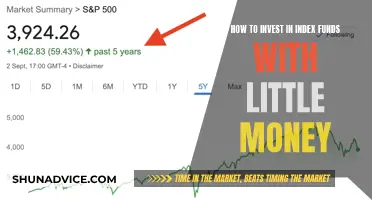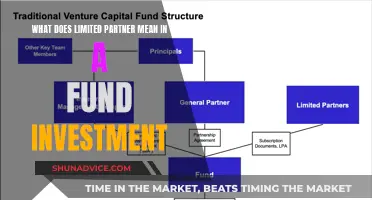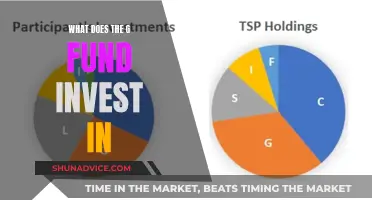
The world of finance is synonymous with Wall Street and the U.S., and it is no surprise that most of the world's largest banks, funds, and investors are based there. One notable exception is Norway's Government Pension Fund Global, which is the world's largest sovereign wealth fund with over $1 trillion in assets. This fund was set up to invest the surplus revenues from Norway's petroleum sector and is managed by the Norwegian Central Bank. Other large investment funds include the Abu Dhabi Investment Authority, the China Investment Corporation, the Kuwait Investment Authority, and SAMA Foreign Holdings in Saudi Arabia. Interestingly, passive investing now accounts for over $20 trillion, a force that is reshaping markets, finance, and capitalism.
| Characteristics | Values |
|---|---|
| Name | Government Pension Fund Global |
| Location | Norway |
| Type | Sovereign wealth fund |
| Owner | Government of Norway |
| Management | Norges Bank Investment Management (NBIM), part of the Norwegian Central Bank on behalf of the Ministry of Finance |
| Assets | Over $1 trillion |
| Companies Invested In | Nestlé SA, Royal Dutch Shell (RDS.A), Amazon (AMZN), Apple (AAPL), Alphabet (GOOGL), Microsoft (MSFT) |
| Equity Holdings | 65.1% |
| Fixed Income | 32.4% |
| Real Estate | 2.5% |
What You'll Learn

Norway's Government Pension Fund Global
The GPFG was established in 1990 to invest the surplus revenues of the Norwegian petroleum sector. The fund's purpose is to invest parts of the large surplus generated by the Norwegian petroleum sector, mainly from taxes on companies, but also from payments for licenses to explore for oil, as well as the State's Direct Financial Interest and dividends from the partly state-owned Equinor. The fund's aim is to ensure the long-term management of revenue from Norway's oil and gas resources, so that this wealth benefits both current and future generations. The future value of the fund depends on sustainable growth, well-functioning markets, and value creation at the companies it invests in.
The GPFG is invested in international financial markets, so the risk is independent of the Norwegian economy. The fund is invested in 8,763 companies across 71 countries, including Apple, Nestlé, Microsoft, and Samsung. On average, the fund holds 1.5% of all the world's listed companies. Most of the fund is invested in equities, with another portion invested in bonds, and the remainder in real estate and renewable energy infrastructure.
Norway's sovereign wealth fund is taking steps to become more active in company governance, with a focus on environmental and social issues, as well as pushing for lower executive pay. The fund also has ethical guidelines that exclude certain companies, such as those involved in human rights violations, tobacco production, and the production of certain types of weapons.
Unlocking Private Credit Funds: A Guide to Smart Investing
You may want to see also

Abu Dhabi Investment Authority
The Abu Dhabi Investment Authority (ADIA) is a sovereign wealth fund owned by the Emirate of Abu Dhabi in the United Arab Emirates. It was established in 1976 by Sheikh Zayed bin Sultan Al Nahyan, the founding president of the United Arab Emirates, with the goal of investing the government's surpluses across various asset classes with a low-risk approach.
ADIA is one of the largest sovereign wealth funds in the world, managing the emirate's excess oil reserves and is estimated to manage $993 billion. It has a highly diversified global portfolio spanning geographies, asset classes, and asset types, including equities, fixed income, treasury, infrastructure, real estate, private equity, and alternatives such as hedge funds and commodity trading advisers.
ADIA's mission is to sustain the long-term prosperity of Abu Dhabi by prudently growing capital through disciplined investment processes. The fund's decisions are based solely on its economic objectives of delivering sustained long-term financial returns, with a focus on value creation. ADIA's strategy involves generating stable returns over the long term within established risk parameters, supported by comprehensive planning processes that align organisational priorities with investment objectives.
The fund's risk management framework is holistic and designed to comprehensively identify and analyse all types of risks across asset classes, ensuring efficient and effective management of any potential issues. ADIA's risk management is embedded in all investment and related activities, from asset allocation to trade execution. The fund's managing director has ultimate responsibility for risk management, with assistance from several committees and departments.
ADIA carries out its investment activities independently of the Government of the Emirate of Abu Dhabi and has no visibility on the government's spending requirements or the activities of other Abu Dhabi-owned investment entities. The fund's assets are not classified as international reserves, and its investments are made solely on economic and financial bases.
Best Funds to Invest in NPS: Where to Start?
You may want to see also

China Investment Corporation
The China Investment Corporation (CIC) is a sovereign wealth fund established by the Chinese government in 2007. It is wholly owned by the Chinese government and manages part of China's foreign exchange reserves.
The CIC was founded with about $200 billion in assets under management (AUM), which has grown to more than $1.3 trillion in 2021 and $1.35 trillion in 2023, making it one of the world's largest sovereign wealth funds. The fund's purpose is to maximise returns at acceptable risk tolerance and improve the corporate governance of key state-owned financial institutions.
The CIC's funding is unlike most non-Chinese sovereign funds, which are typically funded through state revenue from national resources. Instead, the CIC's funding resulted from the state's use of leverage: the Ministry of Finance issued bonds, using the proceeds to buy foreign exchange reserves from the People's Bank of China, which were then used to fund the CIC.
The CIC operates three subsidiaries with two international offices in Hong Kong and New York. The CIC's early foreign investment activities resulted in losses due to investments in the US financial sector before the 2007-2008 global financial crisis. As a result, the CIC shifted its focus to prioritise investments in natural resources and restructured its divisions based on strategic priorities.
The CIC's investment strategy focuses on various sectors, including technology, real estate, infrastructure, and the agricultural sector. The CIC also established a separate, wholly-owned subsidiary called CIC Capital to support the Belt and Road Initiative through foreign direct investment and mergers and acquisitions.
The CIC's investments are intended to promote China's national interests and support the Communist Party's strategic priorities, in addition to seeking financial returns. The CIC has been described as a ""unicorn-maker" for its role in fuelling the growth of the Chinese tech sector and providing funding to the country's semiconductor industry.
Reporting Mutual Fund Investments on Tax Returns
You may want to see also

Kuwait Investment Authority
The Kuwait Investment Authority (KIA) is the world's oldest sovereign wealth fund, founded on 23 February 1953, eight years before Kuwait gained its independence in 1961. As of October 2023, it is the world's fifth-largest sovereign wealth fund, with US$803 billion in assets under management.
KIA was established to manage the financial surpluses of the Kuwaiti Government following the discovery of oil in the country. It manages two main funds: the General Reserve Fund (GRF) and the Future Generations Fund (FGF). The GRF is the repository of all of the State of Kuwait’s oil revenues and income earned from GRF investments. The FGF, established in 1976 with 50% of the GRF balance, has 15% of annual oil revenues added to it, and 10% of all state revenues are transferred to it each year. KIA also manages any other funds entrusted to it by the Minister of Finance.
KIA's mission is to achieve a long-term investment return on the financial reserves entrusted to it by the State of Kuwait, providing an alternative to oil reserves. It aims to achieve a rate of return on its investment that exceeds composite benchmarks by designing and maintaining an uncorrelated asset allocation. KIA is committed to the excellence of Kuwait's private sector, ensuring it does not compete with or substitute for it in any field.
KIA is an independent public authority, with a Board of Directors headed by the Minister of Finance. The majority of the board must be from the private sector, and the Managing Director is appointed from these private sector representatives. An Executive Committee of the Board monitors KIA's activities, and the authority's accounts are reviewed, audited, and approved by two of the world's leading external audit firms.
Small-Cap Funds: Worth the Investment Risk?
You may want to see also

SAMA Foreign Holdings
As the world's largest crude oil exporter, Saudi Arabia's significant oil revenues are managed by SAMA Foreign Holdings. The fund is ranked as the third-largest sovereign wealth fund globally, with assets exceeding $700 billion as of 2020. A large portion of its wealth comes from oil-related companies, with the remainder derived from managing certain Saudi public pensions.
In terms of governance, SAMA Foreign Holdings has a board of directors comprising a governor, vice-governor, and three other members from the private sector. The governor and vice-governor serve four-year terms, while the other members serve five-year terms, all of which can be extended by Royal decree. The senior management team includes the governor, vice-governor, and five deputy governors.
Best Blockchain ETF Funds: Where to Invest?
You may want to see also







